Not too long ago, working from home was a perk that only the trendiest of companies offered their employees (yes, I’m looking at you, Silicon Valley.) Flexible schedules, foosball tables, napping pods, and nitro-cold-brew coffee bars at the workplace were all the rage.

Now, thanks to technology trends that make globalization more accessible, along with the challenges brought upon by a global pandemic, managing virtual teams is much more common than you might expect, while also becoming the new normal. From large corporations to small businesses, managing employees who work from home presents a wide range of benefits and challenges that must be handled properly to maintain the necessary productivity and morale.
After all, something as simple as collaborative work could become a challenge when managing virtual teams. So, to help you get over this new hurdle, here are some tips for working remotely:
1. Keep Everyone Rowing in the Same Direction
When managing virtual teams, it is imperative to make sure that everyone in the group knows how their work affects the rest of the team. Just because they are alone at home, doesn’t mean that they should work in silos.

Collaboration is key for synergy, and synergy is key for small business success. The best way to make sure everyone is up-to-date with what the rest of the team is doing is by holding daily team check-ins. Depending on the size of your team, these should not take more than 15 minutes. A quick video-conference call where everyone can brief the whole team on what they did the day before and what they have planned for the day ahead (one to two minutes max per person, this should not be a project briefing) will yield great results. It is imperative to make sure that these status meetings remain brief and very high paced.
The dynamic should be like that of a hot potato game, where people must exercise restraint by limiting themselves to just the very high-level key points. This way, everyone is aware of what everyone else is doing, allowing them to reach out directly to a specific team member should they have a question about a particular challenge.
Managing employees who work from home also requires scheduled, recurring one-on-one meetings to ensure that everyone on your team is doing well, to go over performance, to manage expectations, and to assist should any team member have a specific challenge. This also demonstrates that as a manager, you are engaged and concerned with your team’s well-being. It is essential to see these as an opportunity to listen to your team and allow for feedback to be able to offer resources if your team members are in need. These touchpoints should not turn you into a micromanager. Focus on building rapport and connecting on a more personal level to keep the employee motivated and engaged with the company’s mission. It is imperative to make sure everyone feels appreciated and valued, even more than usual. After all, the absence of face-to-face interaction may affect some remote employees differently than others. While some people report that working remotely allows for more freedom and empowerment, others feel that the idiom “out of sight, out of mind” comes into play, that their contributions to the business are not as valuable as they once were when working on-premise, or that they are not as valued as other colleagues who do not work remotely.
A study from Harvard Business Review states that “a lack of close contact with people inhibits the formation of trust, connection, and mutual purpose—three ingredients of a healthy social system,” (Maxfield et al., 2018.) And these challenges go beyond affecting your team’s relationships and morale. If not managed properly, employees working from home could affect your business’s bottom line by impacting productivity, results, costs, deadlines, and employee retention.
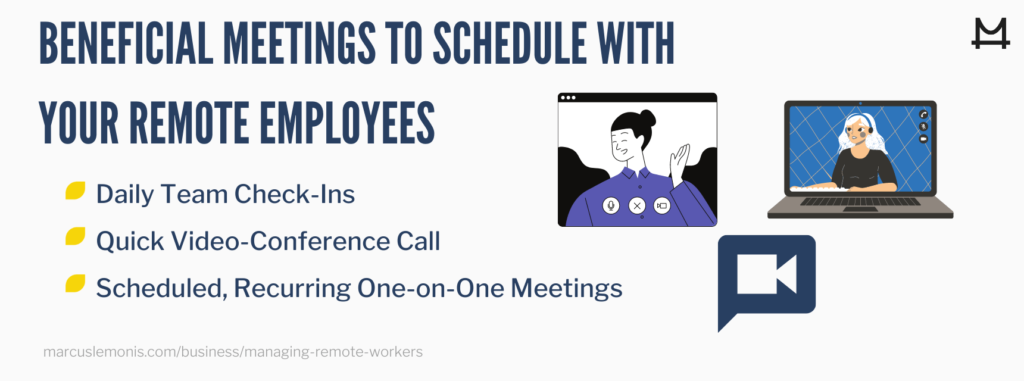
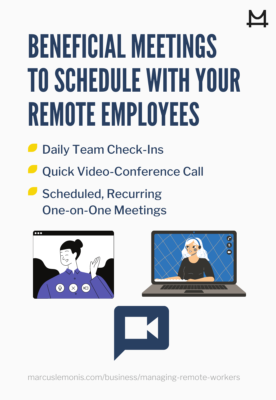
2. There’s No Such Thing as Over-Communicating
Although it may seem like this topic was already covered above, when making a list of tips for working remotely, this one cannot be stressed enough. Constant communication is imperative when managing virtual teams. A virtual open-door policy should also be established; and as a manager, you should make yourself available to the team during business hours.

“That simple gesture—one conveying that you are approachable for direction, advice, counseling or mentoring—can go a long way,” says Allison Allen, Chief Human Resources Officer at Orchard Global Asset Management (Allen, 2017.) One of the hardest things about managing employees who work from home is the isolation they may feel. Emails as a form of communication alone are not enough; “one in four respondents said managers who insisted on some face time with remote employees were more successful,” (Maxfield et al., 2018) even if done through a screen. Remember, it is fundamental to encourage constant communication with your team from the top-down, bottom-up, and laterally among themselves.
3. Embrace Technology
Through digital communication platforms, it is effortless to keep your team connected. From Microsoft Teams, which works seamlessly within Microsoft’s Office Suite, to Google’s G-Suite Essentials that includes Meet Video and voice conferencing, there is a wide range of options to promote a collaborative environment. Other tools such as Zoom and Skype will also help your small business get some needed face-to-face communication at little cost. There are other more business-specific software options, such as Monday.com, Basecamp, Wrike, or Zoho Projects, that also incorporate project management tools that can be tailored to your team’s needs. These have more robust platforms to integrate your team’s communication with the daily workflow and could help your company develop efficiencies such as automating processes and templatizing tasks.
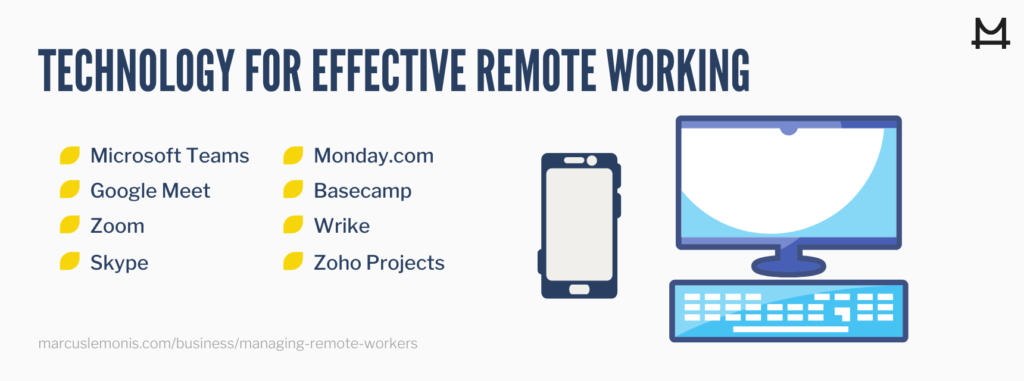
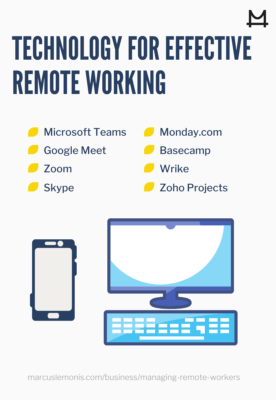
4. Manage Expectations
When it comes to managing virtual teams, it is essential to be clear and realistic about expectations. When you are explicit with your intentions, you provide your team with attainable goals making for happier employees who can live up to those expectations. By talking to your team, you can work together to establish realistic expectations on both parts. When managing employees who work from home, it is crucial to set the team up for success by providing them with a purpose. Explain the “why” when you assign work; this way, you make sure they understand what is expected as a result of each task.
Employees that understand the big picture and know the rationale of their assignments, are much more motivated to achieve big-picture goals (Emergenetics, 2015.)
Also, just as you set your team up for success, it is equally important not to set them up for failure. When assigning projects, and explaining the why, make sure not to leave any team member in the dark about assignments, roles, or deadlines.

5. Focus on Outcomes
Every list of tips for working remotely should include this advice because when managing employees who work from home, there is no way to supervise their every move—and even if you could, you shouldn’t. Employees who are empowered to make their own decisions and manage their own workflow are much happier and perform better. Assign projects with deliverables and deadlines, manage expectations, and keep the communication channels open. But focus on the results, not the process. Everyone’s process is going to be different, and being at home gives them the freedom to work their way. If the project is completed, done well, and within the deadline established, it should count as a win – Celebrate it.
Attempting to micromanage your remote employees will only lead to resentment, unhealthy anxiety (on both parts), and increased staff turnover (Paycor, 2020.)
6. Be Open-Minded and Flexible
Trust is key when managing virtual teams. There is no way to know exactly where they are or what they are doing at any given moment, and that is ok. Remember Tip for Working Remotely number five? Focus on outcomes. Trust your team to do what needs to be done to deliver quality work on time every time. Keep in mind that managing a team who works from home is in no way a babysitting job. Give them the flexibility to accommodate their hours around a schedule that works best for everybody. Let your employees work freely in whatever way inspires them the most and makes them more productive. Of course, there may be situations where flexible schedules will not work for your organization. In certain industries or corporations, it may be imperative that the entire team maintains the same working hours in order to collaborate with team members in other locations. In these cases, ensuring that your team understands your expectations at the outset will minimize issues going forward. Remember, you hired the best team members for the job based on their expertise and professionalism. Now let them do their thing and trust the process.

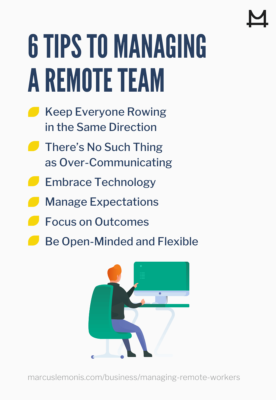

COVID-19 & Working Remotely
The business world changed drastically from one month to the next as a response to the pandemic. Many traditional business owners, who might have been resistant to change, were forced to move their operations remotely for the safety of their employees. A few months into this new normal, opened the eyes of many who felt that being physically present in the office was critical to productivity. Many businesses’ cultures revolved around people needing to be at their desks in order to be productive. Now, many are changing their attitudes on the role of the office because they are realizing—to their surprise—that it works, and it works well.
According to research done by McKinsey, “80% of people questioned report that they enjoy working from home. 41% say that they are more productive than they had been before and 28% say that they are as productive” (Boland et al., 2020). One of the main fears that business leaders had with remote work was that they felt that it would take a toll on teamwork and collaboration to have everyone in separate locations. But now that many businesses have been obligated to adopt technologies for videoconferencing and other forms of digital collaboration (such as Microsoft Teams and Slack), most are surprised by how quickly and effectively these were adopted by their teams. And for many, the results have been better than imagined. As it is, Ernst & Young believes that the pandemic has made obsolete the older, traditional model of physical workspaces; where global, virtual workspaces will be the new normal. In many cases, the workforce has proven that working remotely can be done, and asking someone to make a long commute, to sit at a cubicle for eight hours a day, to accomplish the same work that they could do more comfortably from home, could cause a loss of talent from companies that do not adapt to this new way of life (Verbeemen & D’Amico, 2020).

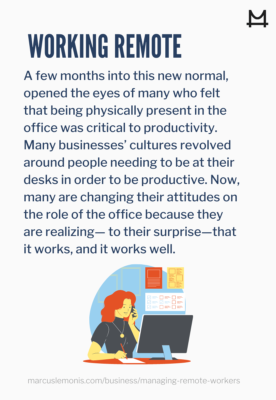
Keeping an Open Mind
It is entirely understandable if you feel that managing employees who work from home can be scary, especially if you have never had to manage virtual teams. A key to small business success is maintaining the flexibility that comes with little infrastructure. Being nimble is going to help you adapt quickly to new trends or changing times. With many people being forced to work from home for the first time, many are quickly becoming accustomed to this new normal. Allowing your team members the flexibility to work remotely, even after it is no longer a necessity, will be essential when it comes to talent retention. Once you master these tips for working remotely, you will notice that your talent pool will become limitless, allowing you to recruit the best talent from all around the world to help you take your business to the next level.
- Do you currently have employees working remotely?
- How has COVID-19 affected your business?
- Which tips are you going to implement into your management strategy?
Allen, A. (2017, April 6). What does an open door policy look like in a virtual workplace? Retrieved from https://www.linkedin.com/pulse/what-does-open-door-policy-look-like-virtual-workplace-allison-allen
Emergenetics International. (2015, September 17). 3 big ideas to motivate employees. Retrieved from https://www.emergenetics.com/blog/three-big-ideas-motivate-employees
Maxfield, J. G., Knight, R., Axtell, P. & Bukholtz, A. (2018, May 14). A study of 1,100 employees found that remote workers feel shunned and left out.
Retrieved from https://hbr.org/2017/11/a-study-of-1100-employees-found-that-remote-workers-feel-shunned-and-left-outPaycor Inc. (2020, January 9). Pros and cons of micromanagement.
Retrieved from https://www.paycor.com/resource-center/micromanagementVerbeemen, E. & D’Amico, S. B. (2020, April 9). Why remote working will be the new normal, even after COVID-19. Retrieved from https://www.ey.com/en_be/covid-19/why-remote-working-will-be-the-new-normal-even-after-covid-19





